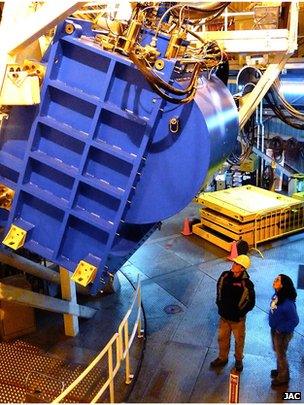Universe seen at 'full throttle'
- Published

At a wavelength of 450 microns, Scuba-2 and the JCMT (middle) are able to resolve sources better than the Herschel space telescope (left). Hubble is then used to follow up Scuba's observations
A major effort is under way to observe the Universe in its most vibrant epoch.
UK, Canadian and Dutch astronomers are looking back 10 billion years in time to see galaxies when they produced stars a thousand times faster than anything in the local cosmos today.
The work employs a new camera recently fitted to the James Clerk Maxwell Telescope in Hawaii.
Scuba-2 is the most powerful instrument of its type ever built.
It detects light at "sub-mm" wavelengths. That is light at wavelengths that are a 1,000 times longer than we can see with our eyes.
The researchers believe the camera will help lay bare one of the most exciting phases in the whole history of the Universe.
"The Milky Way Galaxy today only produces maybe two suns a year amid a population of 100 billion suns," explained Prof James Dunlop from the University of Edinburgh.
"We're now in a very peaceful place and time. But back when we're looking with Scuba-2, galaxies were forming stars a thousand times faster than that," he told BBC News.
Prof Dunlop was speaking here in Manchester at theUK National Astronomy Meeting (NAM), external, where he displayed some of the first really deep Scuba-2 images.
The camera is perfect for the task. The reason these distant starburst galaxies are seen in the sub-mm is a consequence of the rather tortuous route their light takes to get to us.
Stars are born inside cold clouds of gas and dust, and much of their ultraviolet light will be absorbed by the dust grains.
This warms the grains, which then radiate at far-infrared wavelengths. As this energy travels to Earth, it is stretched, or "redshifted" as astronomers say, to the sub-mm by the expansion of the Universe.

Scuba-2 in position on the JCMT
These are, however, very faint light sources and Scuba-2 incorporates superchilled sensors to pick them up.
It is also aided by the fact that the James Clerk Maxwell Telescope sits atop the 4,300m-high Mauna Kea shield volcano.
At that altitude, observations can be conducted above much of the water vapour in the atmosphere that might otherwise block sub-mm emission.
"You have to be very flexible in the schedule of the telescope because when you get these so-called grade one conditions and it's very dry up there, the atmosphere becomes transparent," said Prof Dunlop.
In his NAM talk, the Edinburgh astronomer demonstrated the ability of Scuba-2 to resolve individual sources that could then be followed up by other observatories such as the Hubble Space Telescope to make further detailed studies at range of complementary wavelengths.
"Most of the action we want to see is about three billion years after the Big Bang, so about 10 billion years ago; and it lasts about a billion years," Prof Dunlop said.
"It's the peak epoch when elements heavier than the hydrogen and helium created in the Big Bang are being built in massive stars - all the carbon, oxygen and nitrogen; the stuff that makes us. It's when the cosmic foundry was at full throttle."
.jpg)
The James Clerk Maxwell Telescope has a primary light collecting surface that is 15m across
Jonathan.Amos-INTERNET@bbc.co.uk and follow me onTwitter, external
- Published18 February 2012
- Published3 October 2011
- Published28 July 2011